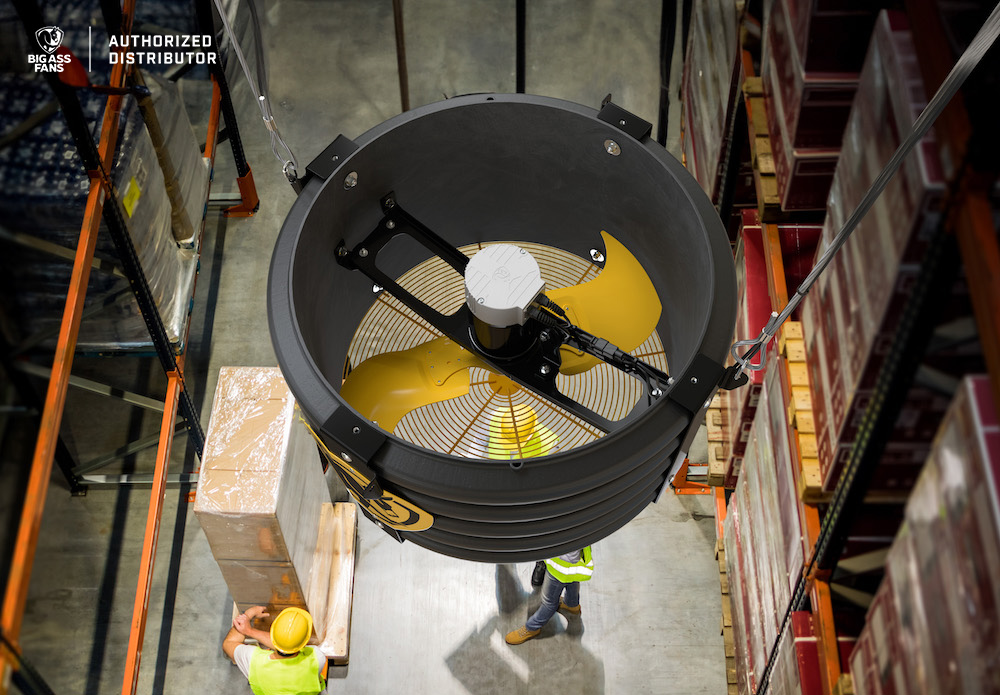During winter, industrial facilities often struggle with condensation and heating inefficiencies. In these environments, high-volume, low-speed (HVLS) fans and destratification fans can both serve a role in improving thermal comfort and energy efficiency. While they can both be employed to solve similar issues, their design and performance characteristics offer unique advantages. So, what is the difference - and how do you choose the right solution for your facility?
What is Destratification?
In large indoor spaces, heat naturally rises, creating a temperature gradient where warm air is trapped at ceiling height and the floor level remains cold. This phenomenon is referred to as thermal stratification. The process of destratification balances temperature gradients, bringing heat down to occupant level and reducing strain on heating systems in winter. Destratification also mitigates the knock-on effects of large temperature differentials, such as condensation or Sweating Slab Syndrome - occurring when warm air interacts with cold surfaces.
HVLS Fans
HVLS fans are large-diameter ceiling fans engineered to slowly and quietly move large volumes of air across a wide coverage area. They effectively destratify spaces by gently pushing warm air down from ceiling height and mixing it with cooler air.
These fans are ideal for large, open spaces with high ceilings such as:
- Warehouses
- Manufacturing plants
- Airports
- Aircraft hangars
- Gyms
- Agricultural or horticultural facilities
The ability of HVLS fans to provide consistent airflow across expansive areas means fewer units will be required compared to smaller fans.
HVLS fans are excellent at solving multiple cross-seasonal issues, with the wide range of speeds providing year-round thermal comfort. They can run at ultra-low speeds in winter for destratification, air quality, and humidity reduction, without cold gusts of air. In summer, operating your HVLS fan at higher speeds enhances evaporative cooling on the skin, making occupants feel up to 6°C cooler without lowering the ambient temperature. This flexibility supplements HVAC systems for improved thermal comfort and energy savings in all seasons.
Key Benefits of HVLS Fans
- Provides cooling in summer and destratification in winter
- Large coverage = fewer units needed compared to small fans
- Offers potential energy savings of up to 30%, year round
- Whisper-quiet operation
- Low maintenance requirements
Destratification Fans
Destratification fans are engineered to effectively combat stratification. Typically compact and installed at ceiling height, they draw in warm air trapped at ceiling height and blow it towards the floor. This forced air mixing breaks up distinct temperature layers to create a more consistent ambient temperature throughout the occupied space.
Destratification fans are well-suited to smaller, more complex layouts for targeted vertical air mixing. They are ideal for:
- Offices
- Classrooms
- Retail spaces
- Warehouses with racking
- Workshops
- Aircraft hangars
If your primary goal is to reduce heating costs and energy consumption in winter, destratification fans are a great solution. Their smaller size and targeted airflow makes them particularly beneficial for congested and obstructed workspaces, although multiple units maybe needed to cover large spaces.
Key Benefits of Destratification Fans
- Reduces energy consumption of heating systems by up to 30-35%
- Eliminates hot and cold spots
- Easy to retrofit in existing buildings
- Ideal for small or hard-to-reach areas
Final Thoughts
Both HVLS and destratification fans provide effective temperature management solutions and reduce heating costs in winter. If your priority is a straightforward, targeted approach to destratification in smaller or segmented spaces, destratification fans are a great solution.
However, in many large facilities, HVLS fans can perform the function of destratification fans, with the added benefits of cooling in summer and broad area coverage.
Your choice will depend on your facilities layout, heating requirements, and long-term goals. For tailored advice, consult our team of airflow experts - give us a call on 09 217 6801 or email us at customerservice@jetblackfans.co.nz
Sign up to our newsletter




